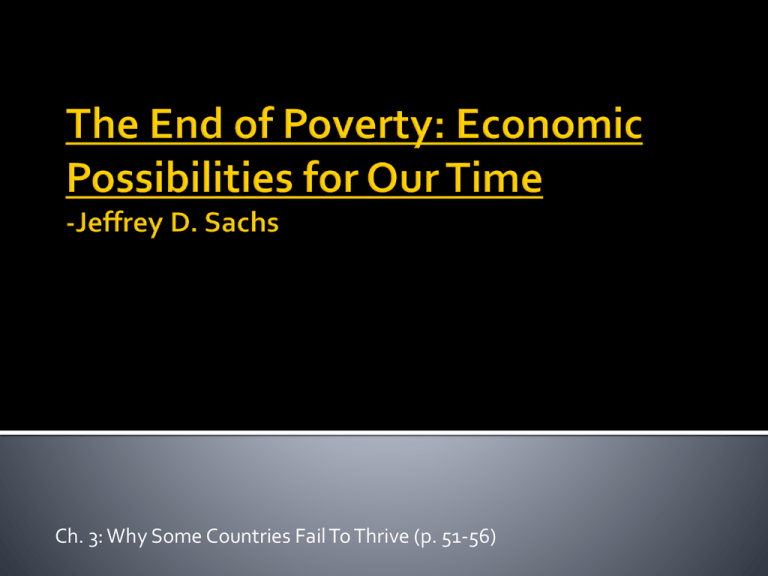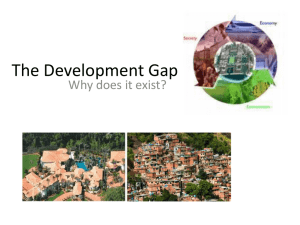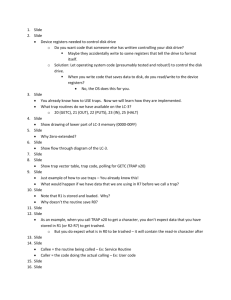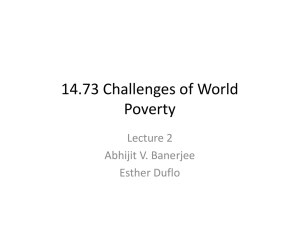File
advertisement

Ch. 3: Why Some Countries Fail To Thrive (p. 51-56) Maize: corn Gross Domestic Product (GDP): market value of all final goods and services produced within the borders of a country during a year Gross National Product: total market value of all final goods and services produced by a country’s residents, no matter where they live, during a year Income Per Capita: total national income divided by the number of people in the nation Extreme Poverty: condition of people living on less than $1.25 per day Capital: the wealth, whether in money or property, owned or employed in business by a person, firm, or corporation# * * + • • • *Definitions from: http://www.factcheck.org/2008/02/gdp-vs-gnp/ +Definition from: http://www.onedayswages.org/about/what-extreme-global-poverty #Definition from: http://dictionary.reference.com/browse/capital 1. 2. 3. 4. Saving Trade Technology Resource Boom (larger/more fertile farms become available) 5/6ths of the world’s population is at least a step above extreme poverty….doesn’t sound too bad, right?! BUT, in a world with almost 7 BILLION people, that means well over ONE BILLION people are living in extreme poverty 1. Lack of saving: capital depreciation may result 2. Absence of trade: could be caused by lack of roads/infrastructure, violence/war, monetary chaos (when money isn’t a reliable medium of exchange), price controls, and other gov’t interventions that limit trade 3. Technological reversal: loss of technological know-how (can happen if parents die) 4. Natural resource decline: e.g. nutrient depleted soil 5. Adverse Productivity Shock: natural disasters like flood, drought, heat waves, frost, pests, or household disease 6. Population growth: household gets bigger but output stays the same 5. Lack of durable housing Insufficient living area Lack of access to clean water Inadequate sanitation Insecure tenure How does your article compare to this list? Which features were mentioned? Were there others you identified? What are they? 1. 2. 3. 4. **UN HABITAT=The United Nations Human Settlements Programme, UN-HABITAT, is the United Nations agency for human settlements. It is mandated by the UN General Assembly to promote socially and environmentally sustainable towns and cities with the goal of providing adequate shelter for all.*** Ch. 3: Why Some Countries Fail To Thrive (p. 56-66) 1. The Poverty Trap: the poorest can’t save because they need their entire income just to survive ▪ They actually deplete natural capital (e.g. cut down trees for firewood w/out replanting) 2. Physical Geography: if a country is land-locked, in mountains, or has no good rivers, harbors, or coastline, they may be economically isolated ▪ Other geographic limitations: -arid conditions (low ag. productivity; more vulnerable to droughts) -ecological conditions ideal for disease **geographic limits can be overcome with enough money; still increases likelihood of falling into a poverty trap*** Central African Republic (CAR) -7th lowest in world GDP (of 221 countries) -48.6% literacy rate -9th lowest life expectancy rate (50.7 years) (US is 50th at 78.37) Stats from: https://www.cia.gov/library/publications/the-world-factbook/index.html 3. Fiscal Trap: Gov’t lacks economic means to improve infrastructure ▪ 3 Reasons: a. Little tax income from poor population b. Inept, corrupt, weak gov’t can’t collect taxes c. Too much international debt 4. Governance Failures: including failure to fix infrastructure, create positive econ. environment, stem corruption, maintain peace/safety, define property rights, enforce contracts, & defend nat’l territory 5. Cultural Barriers: cultural/religious norms stifle development ▪ e.g: women excluded from econ. & pol. life; no education, no economic productivity; usually higher fertility rates ▪ e.g.: ethnic & religious minorities denied access to public services (sometimes ‘ethnic cleansing’ results) -woman whose ears and nose were cut off by Taliban after being caught running away from her abusive husband http://www.time.com/time/covers/0,16641,20100809,00.html 6. Geopolitics: Trade barriers, such as economic sanctions, stifle development 7. Lack of Innovation: little funding provided for research & development (R & D); small markets to test new products….so inventors can’t recoup cost of R & D 8. The Demographic Trap: poor families have many kids; more kids=less resources to care for & educate them; next generation raised in same conditions Ways to avoid The Demographic Trap: Educate girls; more women into workforce Education, laws, & social action for women to more easily make fertility choices Better healthcare for kids; parents less likely to have many kids to care for them in old age http://www.nytimes.com/slideshow/2005/12/22/international/20 051223_ETHIOPIA_SLIDESHOW_2.html











